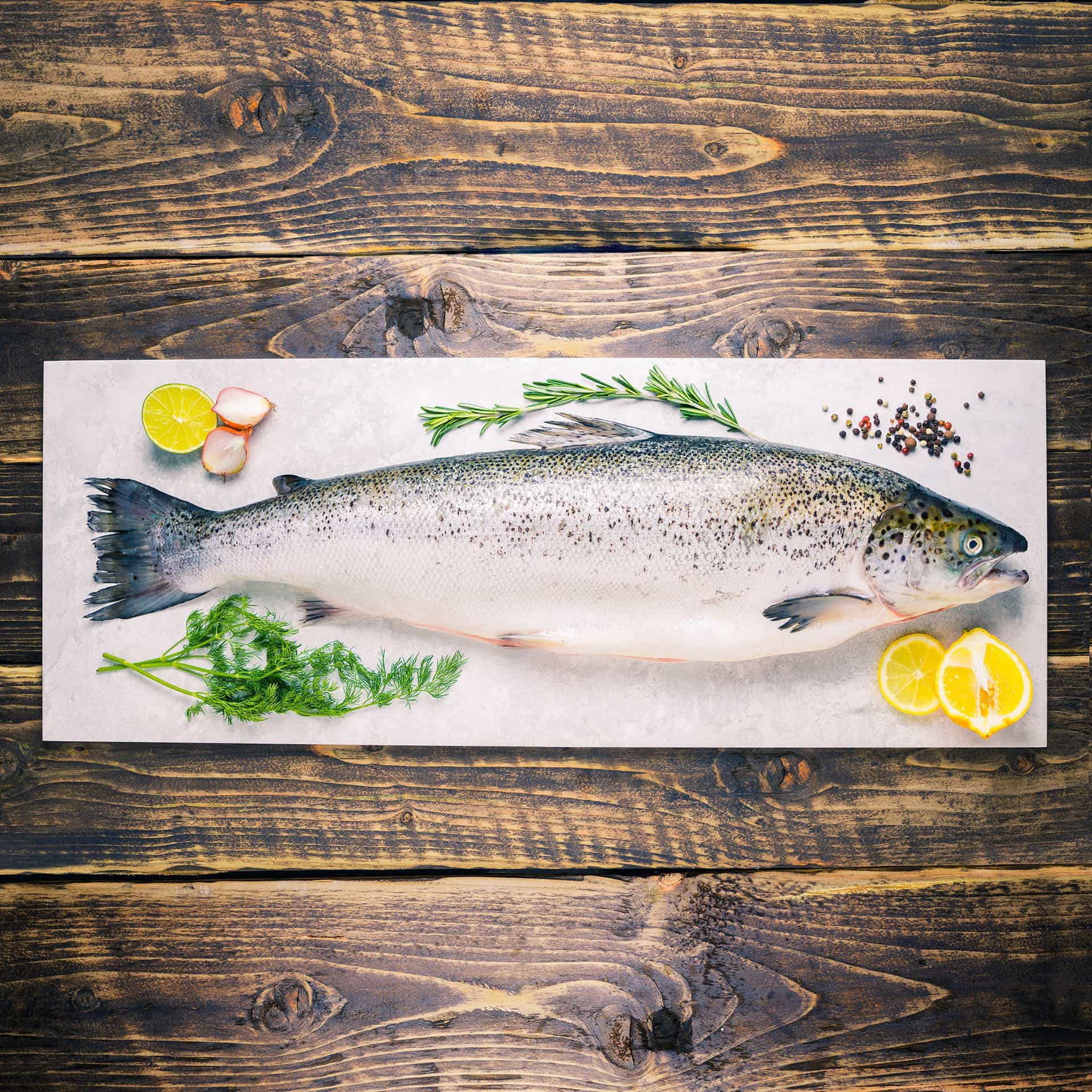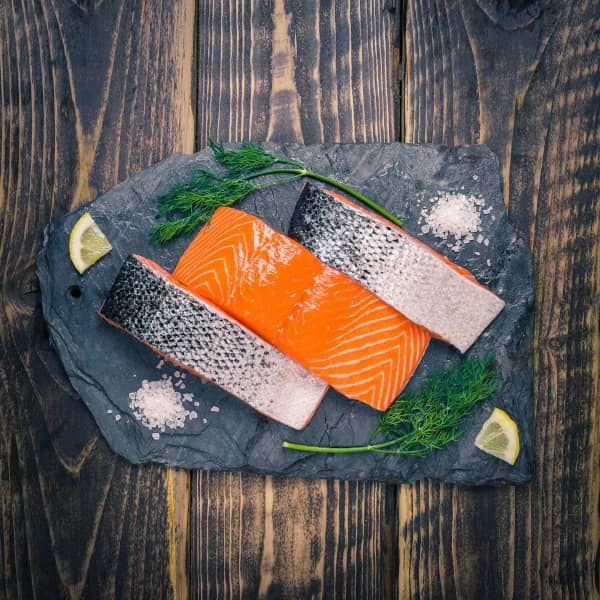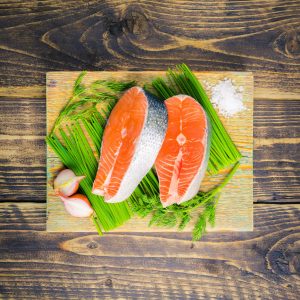
You’d be forgiven for thinking that there’s nothing left to learn about the most popular fish sold in the UK, but there’s much more to this mighty creature than meets the eye. It’s time to train the spotlight on an all-rounder that can be served up as a simple supper or an elegant show-stopper.
WHAT IS SALMON?
Salmon is actually the name used for various species of fish. When we talk about salmon in the UK, we’re usually referring to Atlantic salmon (Salmo salar).
A migratory fish that mainly lives in the sea but spawns in fresh water, the salmon is a fish with a complex life cycle. While some populations live their entire lives in inland waters, most leave the river where they were born, going out to sea to feed and grow. At sea, Atlantic salmon feed voraciously on smaller species of fish and when they mature they return to their natal freshwater habitat to spawn.
Hugh Fearnley-Whittingstall describes salmon as “epic survivors” in The River Cottage Fish Book (A&C Black, 2007) because of the journey they make upstream to the tributaries where they were born to reproduce.
“How a salmon manages to navigate across an open ocean to the same estuary mouth that it left several years before is still a mystery,” he writes. “It’s widely believed that they possess some incredibly accurate receptors that can sense tiny differences in the earth’s magnetic field, and perhaps also in water quality, and that they use these as a homing device. But the honest truth is, nobody really knows.”
CLICK HERE TO BUY SALMON FILLETS
CLICK HERE TO BUY SALMON FILLETS IN A HONEY AND CHILLI MARINADE
CLICK HERE TO BUY SALMON TAIL FILLETS
CLICK HERE TO BUY SALMON STEAKS
CLICK HERE TO BUY WHOLE SALMON

The adult Atlantic salmon averages about 4.5kg in weight and 75cm in length. It has a silvery-blue back with scattered black markings that turn orange when spawning, while the sides and abdomen are golden coloured.
Fish stocks in the wild have dropped significantly over the years but thanks to a rise in aquaculture, salmon is available all year round and at an affordable price.
With pink, fatty, highly nourishing flesh, it’s no surprise this is the most popular fish to eat in the UK. It can be cooked fresh, smoked or eaten raw.
Salmon is an oily fish, mostly due to its high percentage of good saturated fats. It’s well to remember that the higher the fat content of the fish, the more powerful the taste. And living in cold water increases that fat content. Salmon is a full-flavoured fish with colourful flesh, ranging from orange to dark red and it has a delicate, sweet flavour.
In the Middle Ages salmon were cooked in stock, potted, braised, served in ragouts, pâtés or soups, or salted.
WHAT’S AVAILABLE?
The most common cuts of salmon are fillets, which are taken from a boned side and cut lengthwise, parallel to the bone. Salmon tail fillets, as the name suggests, come from the end of the fish and are regarded as premium cuts.
Salmon steaks are cut perpendicular to the spine, cutting through the bone. Some people find the bone adds to the flavour, while another advantage of steaks is the typically lower price of them compared to fillets.
Best of all, though, is whole salmon, which is perfect if you’re cooking for a large group or simply wish to indulge in a piece of culinary theatre.
IS SALMON GOOD FOR YOU?
Salmon is not only fresh and delicious, but it’s also packed with healthy nutrients and is low in calories. A great source of lean protein, vitamins, minerals and antioxidants, salmon is also filled with omega-3 fatty acids, which are essential for a healthy heart, brain and joints.
Per 100g raw salmon
Energy 180kcal
Fat 11g (of which saturated fat 1.9g)
Protein 20.2g
Rich in omega-3 fatty acids, vitamin B12, vitamin B6, niacin, phosphorus and selenium
HOW DO YOU COOK SALMON FILLETS?
Salmon fillets are delicious prepared in a variety of ways including grilling, poaching, pan-frying and baking, and can even be eaten raw as sashimi or sushi.
Salmon is extremely versatile and when it comes to how to cook salmon fillets there are endless options. When cooking salmon fillets, there is no need to remove the skin as this helps to hold the flesh together while cooking. The fish can be cooked using a range of different methods, but many believe the best way to cook salmon fillets is either pan-frying or roasting in the oven (en papillote or drizzled in olive oil) at about 180C.
In the Middle Ages salmon were cooked in stock, potted, braised, served in ragouts, pâtés or soups, or salted
Fillets take no more than five to 10 minutes to cook, depending on the thickness. Pieces of fillet tend to be relatively thick and this makes them robust enough to move around and turn over halfway through cooking. The skin also comes off easily, so if you cook pieces with the skin on, you can lift it off when the fish is cooked before serving of you wish. Once cooked the fish will feels springy and the flesh should be flaky.
Marinading fillets before cooking is a good way to infuse the fish with extra flavour. Try lemon or herbs such as dill, parsley, rosemary or garlic. You might prefer Asian influences with ginger, chilli, soy sauce or a teriyaki marinade.
If you want to impress, try preparing salmon en croute, wrapping the fish in puff pastry and serving the golden baked parcel on the table, ready to cut into slices.

HOW DO YOU COOK SALMON STEAKS?
You can pan fry, bake or grill salmon steaks. Pan-frying is often the best way to cook salmon steaks – it’s quick and easy and only takes 10 minutes.
If you’d like to find out how to cook salmon steaks, try taking a tip from F Marian McNeill in The Scots Kitchen (1929).
Her recipe for Mrs Macleod’s salmon steaks uses salmon, flour, salt, pepper, cayenne, thick cream, anchovy essence and dry sherry.
“Cut two nice-sized steaks in half lengthwise and dip in seasoned flour, to which should be added a dusting of cayenne pepper. Lay them in a well-buttered flat fire-proof dish. Mix two tablespoons of thick cream with a teaspoonful of anchovy essence. Add pinches of salt and pepper and a tablespoon of dry sherry. Pour the mixture over the steaks and bake in a moderate oven for about 25 minutes. Serve in the dish.”
Larousse Gastronomique (Hamlyn, 2009) recommends poaching to get the best out of steaks: “Place some salmon steaks four centimetres thick in enough court-bouillon or fish fulmer to cover them. Bring to the boil, simmer for five minutes then remove from the heat and drain. Serve the steaks topped with pats of butter flavoured with lemon, parsley, chives or tarragon. Alternatively, dress with melted clarified butter flavoured with lemon, maitre d’hotel butter or beurre blanc.”
One of the easiest ways to cook salmon, whether fillets or steaks, is in a baking dish in the oven, just remember to add a little oil to stop it sticking to the dish. Alternatively, steam your salmon by putting it inside a steamer, or wrap it in foil or paper, then steam or bake it.

HOW DO YOU COOK WHOLE SALMON?
According to Delia Smith, the best way to cook whole salmon is wrapped in buttered foil in the oven. In her Complete Cookery Course (BBC Books, 1989) she writes: “If you are serving it cold, it can stay in the foil to cool and the skin can be taken off just before serving. A whole salmon can feed an entire party.”
If you’re looking for the wow factor, impress guests by serving a whole fish at the table.
Whole salmon can be roasted, barbecued or baked in a salt crust but really the best way to cook a whole salmon is poaching. Ideally you want to have a fish kettle when cooking a whole fish, but you can use a roasting tray covered tightly with foil if you don’t have one. To enhance the flavour, add fennel, star anise, bay leaf or seaweed to the water.
Use this method too if you want to learn how to cook a whole salmon for a buffet. It couldn’t be easier. You can, in fact, do it in advance for a stress-free option.
For a richer flavour, roast whole salmon, either in the oven or on a barbecue. Stuff the fish with lemon and herbs and wrap it tightly in foil, then bake for 20 minutes at 180C. To check it’s cooked, pierce the deepest part of the fish for 10 seconds then lay the skewer on the back of your hand – it should be warm to the touch.
SALMON FILLET AND SALMON STEAK RECIPES
There is no shortage of options if you’re looking for salmon recipes.
Do you want healthy salmon recipes? Then look for simple fillet dishes, salads or fish cakes for a pleasing and nutritious seafood supper.
In Fish and Shellfish (BBC Books, 2014), Rick Stein has a delicious recipe for grilled miso salmon with rice noodles, spring onions and beansprouts. He suggests salmon steaks, best grilled medium rare.
“Mix together red miso paste, balsamic vinegar, soy sauce, hot smoked paprika and water for the miso glaze and use to paint the fish steaks. Place the steaks on an oiled grilling tray. Turn on the grill.
“Heat oil in a wok and stir fry garlic, ginger, spring onions and chilli for a couple of minutes, then add the noodles, beansprouts and coriander.
“Grill the fish steaks for about five minutes, turning once. Stir fish sauce into the stir-fried vegetables, then arrange on plates and top with the fish to serve.”
If you have a family to feed, salmon is the perfect ingredient for a hearty fish pie or look for baked recipes and serve with new potatoes and steamed seasonal vegetables. A good tip is that you’ll want an oven on a low heat if you want to learn how to bake salmon at its best.
Easy salmon fillet recipes can be on the table in less than 30 minutes. Try steaming fillets with couscous or noodles, wrapped in tinfoil or baking paper, along with spring onions, herbs and sun-dried tomatoes for a fast and tasty dinner.
Other salmon recipes to try:
- Baked salmon with potato and fennel
- Fish pie
- Pan-fried salmon with wilted spinach
- Teriyaki salmon
- Honey and mustard baked salmon
- Pesto salmon
- Pan-fried salmon with buttered greens
- Salmon en croute
WHOLE SALMON RECIPES
Pleasing whole salmon recipes either poach, roast or barbecue the fish to maximise its flavour. Try stuffing a whole fish with lemon and herbs and roasting it on a bed of fennel and potatoes.
Even the most basic of chefs can turn out an impressive centerpiece of a whole cooked salmon for a get together. If you don’t want to try anything too technical, look out for simple whole salmon recipes.
Wrap the fish in foil and cook slowly in the oven if you have a large number of people and want to spend the minimum of time in the kitchen. Whole salmon cooking time is around 50 to 60 minutes, depending on the size of the fish. That leaves plenty of time to prep vegetables and side dishes.
Other whole salmon recipes to try:
- Spiced roast side of salmon
- Roasted salmon
- Poached salmon with dill and avocado
DO IT YOURSELF
Now you understand the different cuts of fish and the best ways to cook them, you might want to learn how to fillet a whole salmon.
You’ll need a sharp, flexible knife and a pair of kitchen pliers. Lift the fin behind the gill and cut at an angle towards the head. Stop when you get to the back bone. Twist the knife back towards yourself and in big sweeping motions cut with the knife. Then flip the fish over and repeat.
To trim the fillets, use a large, sharp cook’s knife and square them off. Take the belly flap off but don’t throw it away – it can be frozen and you can use it for fish cakes.
Turn the fish and cut through to remove the bones. Then pin bone, using the kitchen pliers. Run your fingers along the flesh to check for any last bones and cut into the sizes of fillets you need.
… Or leave it to the experts
Our fresh whole salmon are farmed in approved fisheries in the north and north-west of Scotland. We believe in only the highest standards of aquaculture to product the best fish. We are slightly biased but our advice is to avoid cheap whole salmon as it’s unlikely to have been bred to these specifications, which means fish lacking in quality and flavour. If you’re looking to buy whole salmon, we think you really want the best.
CLICK HERE TO BUY SALMON FILLETS
CLICK HERE TO BUY SALMON FILLETS IN A HONEY AND CHILLI MARINADE
CLICK HERE TO BUY SALMON TAIL FILLETS
CLICK HERE TO BUY SALMON STEAKS
CLICK HERE TO BUY WHOLE SALMON